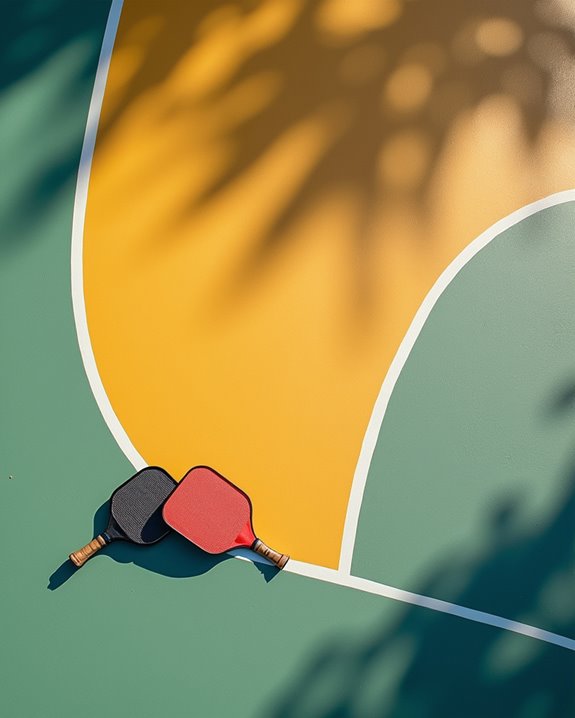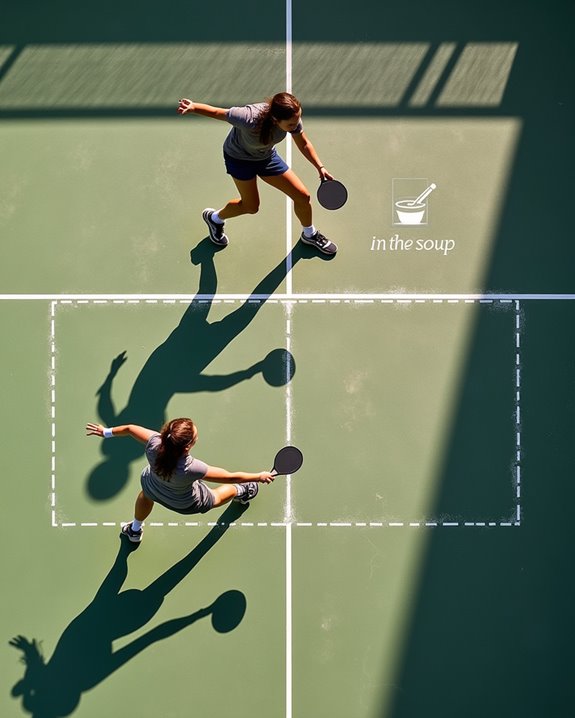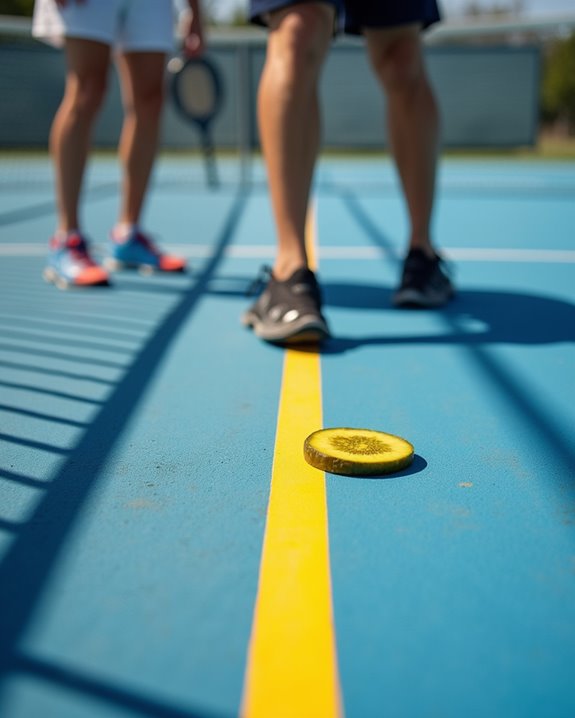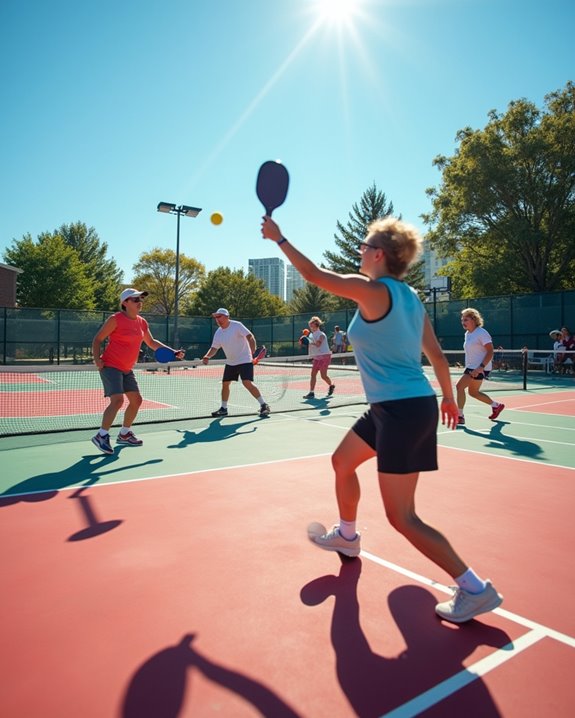Pickleball’s non-volley zone earned its “kitchen” nickname from shuffleboard, where the penalty area was called “10-off” or “the kitchen.” Like getting caught “in the soup,” players who volley from this 7-foot zone near the net commit a fault. You’ll find this culinary term adds flavor to pickleball’s unique vocabulary, alongside other food-related jargon. Understanding the kitchen‘s origins helps you appreciate the game’s rich community culture that’s simmering with tradition.
Key Takeaways
- The term “Kitchen” isn’t found in official rulebooks but emerged as player slang for the Non-Volley Zone.
- It likely originated from shuffleboard, which has a penalty area nicknamed “10-off” or “the kitchen.”
- The name represents a metaphor suggesting “if you can’t stand the heat, get out of the kitchen.”
- Food-related terminology creates a unique vocabulary within pickleball, enhancing the sport’s playful character.
- The term’s informal origins reflect pickleball’s community-oriented spirit and friendly culture.
10 Second-Level Headings for “Why Is Pickleball’s Non-Volley Zone Called the Kitchen?”
Why exactly do pickleball players refer to that critical seven-foot zone near the net as “the kitchen”? This playful term causes confusion for newcomers, even though experienced players use it without a second thought.
Origins of the Kitchen Term
The term “kitchen” doesn’t appear in official rulebooks, where you’ll find “Non-Volley Zone” (NVZ) instead. One compelling theory traces the name to shuffleboard, where “the kitchen” represents a penalty area—similar to how volleying in pickleball’s kitchen results in a fault.
Though absent from official rulebooks, “the kitchen” likely borrowed its name from shuffleboard’s penalty area—creating the perfect metaphor for pickleball’s strategic no-volley zone.
From Family Game to Technical Term
Another theory connects the kitchen term to the game’s family-friendly origins. The founders—dads creating a backyard activity—may have used household terminology that stuck. The kitchen area prevents aggressive net play, preserving the game’s accessible nature while creating a strategic cooking pot of tactical decisions.
The Origins of Pickleball’s Kitchen Terminology

While official rulebooks strictly refer to it as the “Non-Volley Zone,” the quirky term “kitchen” has simmered its way into pickleball’s everyday language.
You’ll find several theories that explain this culinary connection. The most widely accepted recipe for its origins traces back to shuffleboard, where the kitchen refers to a scoring penalty area players endeavor to avoid. Another theory suggests the term evolved from the phrase “in the soup” – indicating you’re in trouble when lingering too long in this seven-foot danger zone.
The confusion about the term’s exact origins adds flavor to pickleball culture. Whether you’re a seasoned player or just starting out, understanding the kitchen’s special rules is essential to avoid getting “cooked” during competitive play.
The Shuffleboard Connection: Kitchen’s Historical Roots

When you’re tracing the etymology of pickleball’s “kitchen,” you’ll find its roots firmly planted in the sandy courts of shuffleboard. The non-volley zone borrowed its nickname from shuffleboard’s “10-off” zone—a penalty area that costs players points when their discs land there.
You’ll notice striking similarities in how both games use this restricted space. In shuffleboard, landing in the kitchen results in point deductions, while in pickleball, it prevents aggressive net play and fosters a more controlled game environment. Both require strategic play as you dance around these forbidden zones.
This connection perfectly simmers with pickleball’s friendly origins. Like a chef who must respect the boundaries of their workspace, you’ll need to master kitchen management to elevate your pickleball recipe for success.
“In the Soup” Theory: Trouble in the Non-Volley Zone

If you’ve ever found yourself trapped in pickleball’s non-volley zone at the wrong moment, you’ll understand why it earned the colorful nickname “the kitchen.” The popular “in the soup” theory suggests this term evolved from an old idiom meaning you’re in trouble—which perfectly describes a player caught lingering in this restricted area during fast-paced play.
When you’re volleying from the kitchen, you’re at a significant strategic disadvantage, often resulting in lost points. The evolution from “in the soup” to “the kitchen” reflects pickleball’s humorous culture while maintaining the metaphor of a hot, challenging space. Players quickly learn that this seven-foot zone can feel as uncomfortable as standing over a boiling pot! This playful terminology adds to the sport’s charm while reminding you of vital positioning strategy.
The Dill Pickle Connection: Food Terminology in Pickleball

The playful nicknames in pickleball extend far beyond just “the kitchen.” Food terminology permeates the sport’s vocabulary, creating a flavorful language that’s uniquely pickleball.
When you’re learning about the term kitchen, you’ll discover it connects beautifully to the game’s origins. Joel Pritchard’s dog Pickles, who chased stray balls, helped establish this dill pickle-related humor throughout the sport. The kitchen represents a potentially chaotic area where players can get into trouble—much like an actual busy kitchen during dinner prep!
This food terminology adds charm to pickleball’s identity, reflecting the lighthearted spirit that makes the game so appealing. You’ll notice how these culinary references make learning the sport more engaging and memorable, creating a distinctive culture that welcomes players of all skill levels.
The Strategic Importance of the Non-Volley Zone

Standing just behind the kitchen line represents your most powerful position on the pickleball court, despite seeming counterintuitive to newcomers. From this sweet spot, you’ll intercept shots faster and control the game’s rhythm like a chef managing their kitchen.
The non-volley zone isn’t just a restriction—it’s the recipe for strategic gameplay. By preventing aggressive volleys near the net, it simmers down play and creates longer rallies. You’ll need to master both spicy volleys and gentle dinks to keep opponents off balance.
Your positioning relative to the kitchen dictates your shot selection. When you’re comfortable at the line, you’ll create more scoring opportunities through controlled exchanges. Remember, success in pickleball isn’t about power—it’s about precise, well-placed shots that force your opponent to make mistakes.
Kitchen Rules: What You Need to Know About the NVZ

Understanding the kitchen rules completely transforms your pickleball game, much like mastering the difference between simmering and boiling changes your culinary results. The non-volley zone extends 7 feet from the net, creating an area where players must not hit a volley while standing in this area.
You can enter the kitchen at any time, but you can’t volley the ball while inside this zone. This causes confusion among some players who mistakenly believe they can never enter the kitchen. In reality, you’re free to step into this area after the ball bounces. Remember that the kitchen line is considered part of the zone itself—even touching it during a volley results in a fault.
The area behind the primary kitchen line requires precise footwork, similar to delicately folding ingredients.
Kitchen Myths and Misconceptions Debunked

Five persistent myths about pickleball’s kitchen zone continue to simmer among players, causing unnecessary faults and confusion.
First, contrary to popular belief, “kitchen” isn’t officially recognized in rulebooks—referees use “non-volley zone” instead. Second, you can’t volley while touching the kitchen line—it’s an immediate fault, like burning toast. Third, entering the kitchen isn’t always prohibited; you may enter after the ball bounces, but volleying while inside is against the rules. Fourth, momentum matters—if your follow-through carries you into the kitchen after volleying, you’ve committed a fault. Finally, the origins of the “kitchen” terminology remain unclear, with various theories simmering in pickleball lore, from shuffleboard connections to playful creator anecdotes—none definitively proven. Understanding these misconceptions will help spice up your game!
Cultural Evolution of Pickleball Terminology

Beyond the misconceptions we’ve just clarified, pickleball’s kitchen terminology reveals a flavorful layer of the sport’s cultural identity.
When you step onto a pickleball court, you’re not just playing a game—you’re participating in a rich cultural narrative. The term “kitchen” for the non-volley zone likely originated from shuffleboard connections, where similar restricted areas existed. Unlike tennis’s technical jargon, pickleball serves up approachable terminology that reflects its community-oriented spirit.
As you exchange volleys with opponents across the net, remember that this seven-foot “kitchen” zone represents more than a boundary—it’s the heart of the game’s unique character. Players worldwide have embraced this culinary-inspired terminology, creating a shared language that simmers with camaraderie and makes pickleball distinctively delicious among racket sports.
How the Kitchen Shapes Gameplay Strategy

While all elements of the pickleball court influence play, the kitchen zone serves as the tactical epicenter that truly defines this sport’s unique flavor. When you’re positioned at the kitchen line, you’ll find yourself in the sweet spot for intercepting volleys and controlling rallies.
Your pickleball strategy should simmer around this non-volley zone. By mastering the art of dinking—those soft, controlled shots that barely clear the net—you’ll force opponents into awkward positions, creating scoring opportunities. Think of it as gently sautéing rather than flame-grilling your shots!
You’ll need to adjust your positioning based on your opponent’s gameplay, sometimes hugging the kitchen line, other times backing up. This dance around the non-volley zone is what makes pickleball both challenging and deliciously addictive.
Frequently Asked Questions
Why Do They Call It a Kitchen in Pickleball?
In pickleball terminology origins, the kitchen zone (non-volley zone) got its name from either shuffleboard’s penalty area or the phrase “in the soup.” You’ll need to understand this area for effective kitchen zone strategies.
Why Is the Kitchen Called the Kitchen?
The kitchen in pickleball terminology origins has two likely explanations: it’s either from shuffleboard’s penalty area or the phrase “in the soup.” You’ll find this non-volley zone significant for strategic play despite not being official rulebook terminology.
Where Did the Term Kitchen Come From in Shuffleboard?
Like entering a risky domain, you’ll find shuffleboard terminology origins trace the “kitchen” to early game rule evolution. It’s believed the name emerged because, historically, this penalty area “cooked” your score when disks landed there.
Can You Ever Step in the Kitchen in Pickleball?
Yes, you can step in the kitchen in pickleball – just not when volleying. Kitchen rules allow entry after a bounce. Many kitchen myths exist, but proper kitchen positioning and understanding kitchen violations prevents footfaults.





